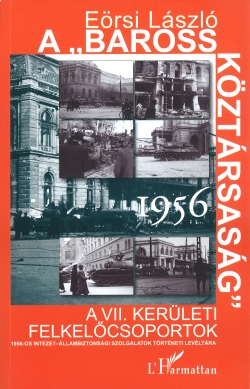László Eörsi: „Baross Republic” 1956: Freedom Fighters’ Groups in the 7th District
Budapest: 1956-os Intézet–L'Harmattan Kiadó, 512 p.
 |
SUMMARY
This volume discusses the events of Hungary's 1956 armed uprising in Budapest's Seventh district (Erzsébetváros). Participants in the military resistance of this district were primarily composed of disadvantaged youth and repeat convicts, eager to participate in the destruction of the Stalinist regime. These groups formed following the first wave of military clashes in October. They participated heavily in the fights in November, and out of Budapest's downtown districts, they held out the longest against the overwhelming Soviet forces.
Although it might be hard to believe today, the majority of these insurgents fought for the realization of some kind of third-road, Yugoslav-type, independent socialist political establishment. Expressions of extreme-right beliefs among their ranks were just as rare as those of liberal views. Only an insignificant minority within these groups were supporters of Horthy (the political leader of interwar Hungary) or Mindszenty (the head of the Catholic Church after 1945).
The largest group in the Seventh district, and thus the third-largest group in Budapest itself, was the one that emerged around Baross Square under the ironhanded command of the mechanic László Nickelsburg. Initially they acted independently, calling themselves the "Baross Republic," but they later joined the unified National Guard. Among the various armed groups in Bu-dapest, members of this group were the most active participants in the siege of the Party headquarters at Köztársaság Square, and they also had their share in the vengeance that followed. On the night of November 4, after their base was destroyed by the Soviet forces, the group scattered but continued the struggle for five more days. Many of its members chose the path of political resistance that unfolded in the Péterfi Sándor Street hospital for several weeks.
Led by István Klauber, who had been recently freed from prison by dem-onstrators, and composed overwhelmingly of what Party functionaries would have called "lumpenproletariat" (an underclass whose members often had a criminal record), the armed group of Thököly Street fought against the occu-pying forces with astonishing success and did not lose a single man to combat.
After the head of the government declared cease fire, several groups formed in the area around Lenin Boulevard. Among them were the "Farkas-group," led by insulation worker Dezső Kovacs, and the Csengery Street group, which occupied the building of the district local government under the command of transport worker Lajos Steiner. A national guard group also formed in the neighboring police precinct in Harsfa Street, but this group remained under the control of police officers and party functionaries. Only after the second Soviet invasion was leadership of this group taken over by "genuine" revolutionaries commanded by electrician Ferenc Bencze. Several members of these groups took part in the siege of the Köztársaság Square Party headquarters. During the November battles, a mixed group of these armed insurgents occupied the Hotel Royal and the Ministry of Transport and Postal Services buildings, where they held out until November 9-10.
During the ceasefire proclaimed by the government, the Communist Party's district headquarters at the Lenin Boulevard was occupied by armed civilians, who set up and ran a "loudspeaker news." They also resisted the Soviet occupying troops under the leadership of bus conductor Laszlo Szenes. The neighboring New York Palace, where the most important revolutionary newspaper Truth was edited, was also defended by the "Pest lads," as the armed insurgents were called in popular memory.
After the suppression of the revolution, many insurgents from the Erzsébetvaros district left Hungary. From among those who remained or returned from the West, Ho were convicted. Compared to the armed groups in other parts of the city, the revolutionaries of this district received the highest number of death sentences: 37 in total. None of them were pardoned.

